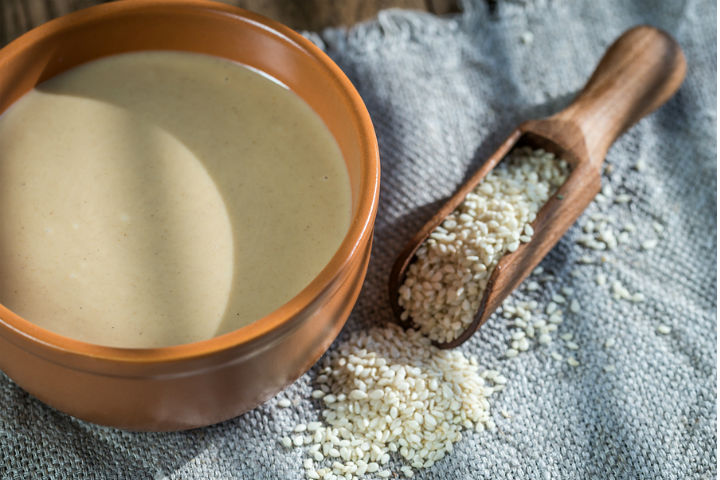Tahini is made from sesame seeds which are soaked, toasted, crushed and ground into a delicious nutty paste. It’s highly versatile and a great alternative to peanut butter or any other nut butter especially if you are sensitive.
Sesame seeds are known as the “Queen of Oilseeds” due to its high content of natural oils, namely polyunsaturated fatty acids (PUFA). Sesame seeds are also a rich source of protein, dietary fibre, antioxidants, phytoestrogens, phytosterols, vitamins E and B, minerals (zinc, magnesium, phosphorus), phytates and lignans such as sesamin, sesamolin, sesaminol, sesamolinol. This unique nutrient profile ensures that this seed does not oxidise and become rancid easily like many nuts and seeds.
Tahini is a nutritional powerhouse with many health benefits in the body such as:
Heart Health
- Helps reduce high blood pressure;
- Helps prevent blood clot formation and heart disease;
- Improves blood lipid profiles (triglycerides, LDL) ;
- Improves our antioxidant status which is protective to the heart;
- Is a useful treatment for arteriosclerosis, a chronic inflammatory disease characterized by fatty buildup in the arteries.
Hormone Health
Sesame seeds contain phytoestrogens. Many have shied away from phytoestrogens because they can mimic estrogen and act as estrogen antagonists. However they possess many powerful health benefits too. Some of these are:
- Hormone balancing in women over 50 or those with low estrogen levels;
- Relief and prevention of common menopause symptoms such as hot flushes, low sex drive and bone loss;
- Maintenance of healthy, strong bones and prevention of osteoporosis and;
- Prevention of certain forms of cancer such as breast and ovarian.
Skin Health
Sesame seeds are a great source of amino acids, vitamin E, B, zinc and healthy fats which help prevent early signs of aging and revitalise the skin. It’s healthy fat content is anti-inflammatory and hydrating to the skin. Zinc is essential for hormone health, repair of tissue and the production of collagen, a protein that gives skin its firm youthful and elastic quality.
Cancer Prevention
The sesamin in sesame oil has been studied for its ability to prevent the growth of various cancer cells, such as leukemia, multiple myeloma, colon, prostate, breast, lung, and pancreatic cancer. Sesame seeds improve our antioxidant status which has a cancer preventative effect.
Diabetes
Sesame oil decreases high blood glucose levels and is an excellent supportive food for those with diabetes.
The best way to have tahini
Hulled or Unhulled
Normally I would say go for the unhulled however the seed coat contains oxalic and phytic acid. This makes it harder for the body to absorb the calcium, phosphorus and other nutrients found in the seed coat. The process of dehulling may actually make these nutrients more available to us. Unfortunately there is very little research on which form is best.
Organic Vs Non Organic
Organic tahini is inexpensive so do yourself a favour and buy organic. This way you reduce consumption of pesticides and chemicals which inflame the body and disrupt our hormones and gut flora. Check the ingredients and purchase tahini with no added oils. Buy those that contain pure ground sesame seeds instead. Or if you are super keen. Make your own.
How much?
Tahini is strong in flavour and high in omega 6 so moderation is key. Aim for 1-2 tbsp per serve. Admittedly I am a bit partial to overdoing it.
Storage
Keep tahini in the fridge to preserve that deliciously rich, healthy fat content.
Texture and taste?
Smooth and creamy with a slight nutty taste.
Just how versatile is our humble friend?
Breakfast
Smoothies
Creamy Crunchy Jaffa Thickshake
Dressings and dips
Roast Zahini Dip
Snacks and Dessert
Or straight onto a piece of delicious, hot, gluten free bread such as Gluten-Free Pumpkin and Ginger Bread
Now over to you. How do you like to have tahini?
References
http://www.ncbi.nlm.nih.gov/pmc/articles/PMC4127822/
http://www.ncbi.nlm.nih.gov/pubmed/21842753
http://www.ncbi.nlm.nih.gov/pubmed/21577091
http://www.ncbi.nlm.nih.gov/pubmed/8979168
http://www.ncbi.nlm.nih.gov/pmc/articles/PMC1942178/
http://www.ncbi.nlm.nih.gov/pmc/articles/PMC4127822/#ref7
http://www.ncbi.nlm.nih.gov/pmc/articles/PMC4127822/#ref25
http://www.ncbi.nlm.nih.gov/pubmed/15033755
http://www.ncbi.nlm.nih.gov/pubmed/20460401
http://www.ncbi.nlm.nih.gov/pmc/articles/PMC4764959/



I love me some tahini! I love stirring through some raw honey and dolloping on a bowl of fresh blueberries with a sprinkle of cinnamon and chia seeds (unfortunately I prefer the taste of the unhulled … damn that oxalis acid!)